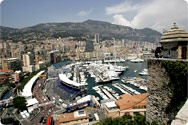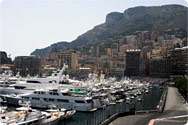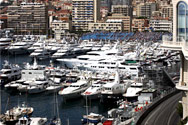|
|
Taming the Mean Streets of Monte Carlo
19.05.2008
For nearly 80 years, the Monaco Grand Prix has challenged drivers to tame the tight and twisty streets of a race track which winds its way through the second smallest nation on earth.

At just two square kilometres, and with the highest national population density in Europe, Monaco is unique on the Formula 1 calendar. That 350km/h race cars still do battle on its treacherous turns in the 21st century is testament to the enduring fascination of the Monaco Grand Prix.
For most in Formula 1, Monaco is in equal parts a trial and a joy; with the tight confines challenging everyone in the paddock but the history, glamour and unrivalled atmosphere stoking the flames of passion in all motorsport enthusiasts.
Richard Cregan, Panasonic Toyota Racing Team Manager, sums it up: “Monaco is one of the great races of the year. It is an icon in terms of Formula 1 and a driver on a flying lap in Monaco, I believe, earns his salary for the year right there. But you also have the great atmosphere of being in Monaco; the glitz and the glamour combined with Formula 1 racing. You have an enthusiasm, a passion that you probably don’t get at too many circuits in Formula 1.”
Jarno Trulli has a passion for racing and some incredible memories of Monaco’s legendary streets, having won his first Grand Prix in 2004 with a superb performance from pole position. Of course, that kind of result will always give happy memories but regardless, for Jarno, Monaco is always a special place.

“My race win here was the perfect Monaco souvenir,” he says. “I have a lot of fun at Monaco, it is a very different grand prix and I find it very exciting. There is more risk there and you need a good feeling with the car to succeed. It is difficult to explain why this race track is so special. The guard rail is very close and it seems very fast; it is a great challenge and you need total concentration. It is just a great circuit.”
With unforgiving walls just centimetres away, drivers are given no margin for error, which makes Monaco one of the most mentally demanding races of the year. In terms of the cars, it may be tempting, logical even, to assume the slowest race on the calendar is the least demanding, but that could not be further from the truth. Monaco is not only a unique challenge for a driver; it places very special demands on a Formula 1 car as well.
With so many slow speed corners, drivers spend almost the entire 3.34km lap working their way through the gears, adding up to nearly 4,000 gear changes over a race distance, and that is just one element of Monaco- mechanical menace, as Chief Engineer Race and Test Dieter Gass explains.
“It is a circuit which is mechanically very demanding because there are a lot of gear changes due to the fact you are always working in the lower part of the ratios,” he says. “So there is a lot of work for the gearbox - between every corner the driver is shifting up and down.
“This track is very demanding for the brakes as well because of the low average speed and the lack of long straights where you would cool down your brakes. Consequently the average temperature of the brakes is very, very high and this means you have to be very carefully about your brake cooling.”

At other circuits, long straights represent welcome relief for an engine, with relatively cooler air blasting past the radiators at 350km/h to trim temperatures, but Monaco has a distinct shortage of straights. Luckily, that also means high downforce, rather than high top speed, is the order of the day, so there is more leeway than normal for aerodynamics to be tweaked to help out.
“The aerodynamic package will be our maximum downforce package,” says Head of Aerodynamics Mark Gillan. “We are not so concerned about drag so you will see appendages going on the car which wouldns normally be on for reasons of efficiency and you will see different cooling options on the car as well to try to get maximum cooling.
You also tend to try as much front aero balance, with big front wings, so really the car is trimmed for maximum downforce.”
For all Monaco’s technical challenge, its appeal is more basic; just to be so close to the action, surrounded by the fastest racing cars on earth, is an intoxicating experience, even for Formula 1 regulars.
“There is no run-off so the cars are very close to the walls and close to the public and that is probably what makes it so special for us,” says Senior General Manager Chassis Pascal Vasselon. “It is the only place where you really feel, hear and smell the speed of the cars. For me every Monaco Grand Prix is really special - it is where I really feel what I am doing.”
movies |
||||
|
